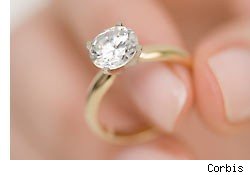
Purchasing a quality diamond can be a difficult process if you are not aware of what you should be looking for. Many diamonds that are purchased are for engagement rings and anniversary rings, however, diamonds are not only for special occasions and couples. Women are also purchasing diamonds for themselves.
Regardless of why you are purchasing diamond jewelry or the occasion, this post will help you identify what to look for. “New sources of mined diamonds are coming into the global market,” Paul Swinand, a stock analyst with Morningstar, who covers the jewelry sector, tells DailyFinance. And the U.S. is benefiting from a broader mix of suppliers, “which makes for more competitive pricing from the low-end to high-end diamond,” he says.
“Four Cs” of Diamonds
The Four C’s refer to the characteristics that determine a diamond’s quality: carat, color, clarity and cut. The GIA’s diamond-grading system, which factors in those C’s, has become the industry standard for professional jewelers.
1) Carat
Carat refers to the weight of the diamond. Generally speaking, “If you’re on a tight budget, a one-carat diamond will be out of your [price range],” Shor says. The larger the diamond, the more expensive that you can expect it to be. however, once mounted the difference between half a carat and .44 will not be as noticeable to the eye, but a large difference in price.

Diamond grades D, K and Z
2) Color
In a white diamond, this measures how close the diamond is to white.
Colorless diamonds, which get the highest grades of D, E, and F, are considered premium because they allow for the greatest reflection of light and, therefore, emit the most dramatic sparkle, according to the Diamond Buying Guide. They also command a higher price. S- Z are the lowest grade on the scale and have a light color to them making them more affordable for the buyer. Most buyers would prefer the highest grade, but going with a diamond that is rated H, I, J or K, which will still look good, drops the price between 25% and 35% from that of a D, E or F rated stone. Yellow gold makes a lower grade stone less obvious because the slight amounts of yellow in a diamond aren’t as apparent as they would be in white metal mountings. Color becomes more important as carat weight increases, because color is easier to perceive in a larger diamond.
3) Clarity
The GIA’s 11-grade clarity scale quantifies a diamond’s blemishes, both inside and outside. Grades range from F for Flawless — which is extremely rare — to Included 3, or I3, the lowest clarity grade. But a diamond can still look luminous even when it falls below the four highest grades. (These are F for Flawless; IF for Internally Flawless; VVSI-VVS2 for Very, Very Slightly Included; and VSI-VS2, which means Very Slightly Included, according to the Diamond Buying Guide.) A lower-clarity stone are alot more affordable. These include SI1 and SI2, which are “slightly included.” They are a notch above the lowest clarity grades of I1, I2 and I3.
4) Cut
Experts agree that this is where you don’t want to cut corners: the cut. The cut of a diamond has a huge influence on the diamond’s reflective qualities and you should choose a cut in the top two ratings of the GIA scale which include:
Excellent |
Maximum fire and brilliance. Reflects nearly all of the light that enters the diamond, creating exceptional sparkle and life. |
Very Good |
Properly reflects most of the light that enters the diamond, producing superior fire and brilliance. Under normal lighting conditions, appears very similar to Excellent Cut, but for a lower price. |
Good |
Reflects a majority of the light that enters the diamond, for an above average appearance. An excellent value compared to higher cut grades. |
Fair |
Allows much of the light entering the diamond to escape from the sides or bottom, reducing perceived fire and brilliance. More acceptable in diamonds of less than .75 carats, where differences in sparkle are more difficult to perceive. |
Poor |
Allows most of the light entering the diamond to escape from the sides or bottom. The diamond may appear noticeably dull and lifeless, even to an untrained eye. Lumera does not offer Poor cut diamonds. |
Be sure to ask the retailer to see a diamond-grading report, such as one from the GIA or the American Gem Society, which includes an assessment of each diamond’s four C’s. These reports come from what the jewelry industry considers to be the most credible diamond-rating labs, Ken Gassman, president and founder of the Jewelry Industry Research Institute, tells DailyFinance.